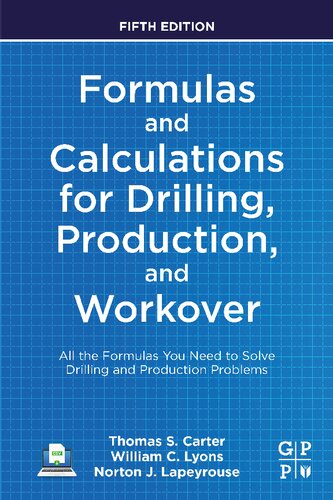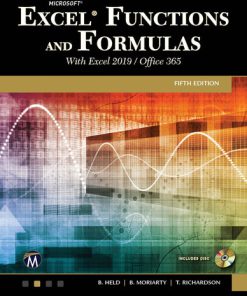Formulas and Calculations for Drilling Production and Workover 5th Edition by William Lyons, Thomas Carter, Norton Lapeyrouse 0323905498 9780323905497
$50.00 Original price was: $50.00.$25.00Current price is: $25.00.
Formulas and Calculations for Drilling Production and Workover 5th Edition by William Lyons, Thomas Carter, Norton Lapeyrouse – Ebook PDF Instant Download/Delivery: 0323905498, 9780323905497
Full download Formulas and Calculations for Drilling Production and Workover 5th Edition after payment

Product details:
ISBN 10: 0323905498
ISBN 13: 9780323905497
Author: William C. Lyons, Thomas Carter, Norton J. Lapeyrouse
Updated for today’s engineer, Formulas and Calculations for Drilling, Production, and Workover, Fifth Edition delivers the quick answers for daily petroleum challenges. Starting with a review of basic equations, calculations, and many worked examples, this reference offers a quick look up of topics such as drilling fluids, pressure control, and air and gas calculations. The formulas and calculations are provided in either English field units or in metric units. Additional topics include cementing, subsea considerations, well hydraulics, hydraulic fracturing methods, and drill string design limitations. New formulas include geothermal drilling, horizontal wells, and temperature workover. Formulas and Calculations for Drilling, Production, and Workover, Fifth Edition continues to save time and money for the oilfield worker and manager on the job with an easy layout and organization, helping you confidently conduct operations and evaluate the performance of your wells.
- Updated to include geothermal drilling calculations for lower emission operations
- Offers detailed calculations for the most common daily challenges
- Compact with only the most useful information whether you’re in the office or the field
Formulas and Calculations for Drilling Production and Workover 5th Table of contents:
Chapter 1: Basic equations
Abstract
1.1: Terminology
1.2: Mud weight MW (lb/ft3), mud weight MW (ppg), and specific gravity (SG)
1.3: Hydrostatic pressure (P) and (p)
1.4: Pressure gradient ∇ (psi/ft), G (ppg)
1.5: Mud pump output q (bbl/stk) and Q (gpm)
1.6: Hydraulic horsepower
1.7: Estimated weight of drill collars in AIR
1.8: Open hole and tubular capacity and displacement formulas
1.9: Amount of cuttings drilled per foot of hole
1.10: Annular velocity (AV)
1.11: Pump output required in GPM for a desired annular velocity, ft/min
1.12: Bottoms-up formula
1.13: Pump pressure/pump stroke relationship (the Roughneck’s formula)
1.14: Buoyancy factor (BF)
1.15: Formation temperature (Tf)
1.16: Temperature conversion formulas
Appendix: Supplementary material
Appendix: Supplementary material
Chapter 2: RIG calculations
Abstract
2.1: Accumulator capacity
2.2: Slug calculations
2.3: Bulk density of cuttings using the mud balance
2.4: Drill string design
2.5: Depth of a washout in a drill pipe
2.6: Stuck pipe calculations
2.7: Calculations required for placing spotting pills in an open hole annulus
2.8: Line size for a low pressure system
Appendix: Supplementary material
Appendix: Supplementary material
References
Bibliography
Chapter 3: Pressure control
Abstract
3.1: Normal kill sheet
3.2: Pressure chart: Prepare a chart with pressure and strokes
3.3: Kill sheet with a tapered string
3.4: Kill sheet for a highly deviated well
3.5: Maximum anticipated surface pressure
3.6: Trip margin (TM)
3.7: Sizing the diverter line
3.8: Fracture gradient (FG)
3.9: Formation pressure tests
3.10: Kick tolerance (KT)
3.11: Kick analysis
3.12: Gas cut mud weight measurement calculations
3.13: Gas migration in a shut-in well
3.14: Hydrostatic pressure decrease at TD caused by formation fluid influx due to a kick
3.15: Maximum pressures when circulating out a kick (Moore equations)
3.16: Gas flow into the wellbore
3.17: Pressure analysis
3.18: Stripping/snubbing calculations
3.19: Subsea considerations
3.20: Workover operations
3.21: Controlling gas migration
3.22: Gas lubrication
3.23: Annular stripping procedures
3.24: Barite plug
Appendix: Supplementary material
Appendix: Supplementary material
Bibliography
Chapter 4: Drilling fluids
Abstract
4.1: Mud density increase and volume change
4.2: Mud weight reduction with base liquid dilution
4.3: Mixing fluids of different densities
4.4: Oil-based mud calculations
4.5: Solids analysis
4.6: Solids fractions (barite treated muds)
4.7: Dilution of mud system
4.8: Evaluation of hydrocyclones
4.9: Evaluation of centrifuge
4.10: Mud volume required to drill 1000 ft of hole
4.11: Determine the downhole density of the base oil or brine in the mud at depth of interest in ppg
Appendix: Supplementary material
Appendix: Supplementary material
Bibliography
Chapter 5: Cementing calculations
Abstract
5.1: Cement additive calculations
5.2: Water requirements
5.3: Field cement additive calculations
5.4: Weighted cement calculations
5.5: Calculate the number of sacks required for cement job
5.6: Calculations for the number of feet to be cemented
5.7: Setting a balanced cement plug
5.8: Differential hydrostatic pressure between cement in the annulus and mud inside the casing
5.9: Hydraulicing casing
5.10: Pump strokes to bump the plug
Appendix: Supplementary material
Appendix: Supplementary material
Bibliography
Chapter 6: Well hydraulics
Abstract
6.1: System pressure losses
6.2: Equivalent circulating “density” ECD (ppg)
6.3: Surge and swab pressure loss
6.4: Equivalent spherical diameter for drilled cuttings size used in slip velocity equations
6.5: Slip velocity of cuttings in the annulus
6.6: Carrying capacity index
6.7: Pressure required to break circulation
6.8: Initial gel strength guidelines for top hole drilling in high angle wells (after Zamora)
6.9: Bit nozzle selection—Optimized hydraulics
6.10: Hydraulic analysis
6.11: Minimum flowrate for PDC bits
6.12: Critical RPM: RPM to avoid due to excessive vibration (accurate to approximately 15%)
Appendix: Supplementary material
Appendix: Supplementary material
Bibliography
Chapter 7: Drilling and completion calculations
Abstract
7.1: Control drilling—Maximum drilling rate (MDR) when drilling large diameter holes (14¾ in. and larger) in ft/h
7.2: Mud effects on rate of penetration
7.3: Cuttings concentration % by volume
7.4: “d” Exponent and corrected “d” exponent
7.5: Cost per foot
7.6: Rig loads
7.7: Ton-mile (TM) calculations
7.8: Hydrostatic pressure decrease when pulling pipe out of the hole
7.9: Loss of overbalance due to falling mud level
7.10: Lost circulation
7.11: Core analysis technique
7.12: Temperature correction for brines
7.13: Tubing stretch
7.14: Directional drilling calculations
7.15: Hole washout
Appendix: Supplementary material
Appendix: Supplementary material
Bibliography
Chapter 8: Air and gas calculations
Abstract
8.1: Static gas column
8.2: Direct circulation: Flow up the annulus (from annulus bottomhole to exit)
8.3: Direct circulation: Flow down the inside of the drill pipe (from the bottom of the inside of the drill string to the injection at the top of the drill string)
8.4: Reverse circulation: Flow up the inside of tubing string
8.5: Reverse circulation: Flow down the annulus
8.6: Reverse circulation: Adjusting for reservoir pressure
Appendix: Supplementary material
Appendix: Supplementary material
Bibliography
Appendix A
A.1: Tank capacity determinations
A.2: Pipe capacities, displacements, and weight calculations
Appendix: Supplementary material
Appendix: Supplementary material
Appendix B: Conversion factors
Appendix C: Average annual atmospheric conditions
People also search for Formulas and Calculations for Drilling Production and Workover 5th:
formula for production
how to calculate foir formula
how to mix formula ratio
how to calculate combinations formula
Tags:
William Lyons,Thomas Carter,Norton Lapeyrouse,Formulas
You may also like…
Uncategorized
Computers - Computer Certification & Training
Excel Functions and Formulas Learn Simple Excel Functions and Formulas Emenwa Global
Chemistry - Technical & Industrial Chemistry
Chemical Calculations 3rd Edition by Paul C Yates ISBN 9781003043218 1003043216
Medicine - Health-Related Professions
Nursing Calculations and IV Therapy For Dummies UK Claire Boyd
Reference - Writing
Beyond Conversation Collaboration and the Production of Writing 1st Edition William Duffy
Computers - Web Development
Django for Professionals Production websites with Python Django 4 0 William S. Vincent
Crime Thrillers Mystery Detective Crime Fiction
Computers - Applications & Software
Microsoft Excel Functions and Formulas With Excel 2019 Office 365 5th Edition Bernd Held











